Artist Tracey Adams, who currently has a solo show on view at the Bryant Street Gallery in Palo Alto, draws her ideas and inspirations from a wide variety of fields including music, mathematics and science. In her varied works, all of these disciplines come together in visual form, in a process that Adams characterizes as involving a "synthesis of intention and chance."
I recently interviewed Tracey Adams and asked her about her background, her interests, and her priorities.
Tracey Adams in Conversation with John Seed
![2014-08-08-TraceyatWinfield2014.jpg]()
Tracey Adams
Tell me about your childhood and formative experiences: how old were you when you first showed an interest in art?
I'm very fortunate that my parents loved art and collected Japanese prints. My mother had a small ceramics studio in our house where I could play and I always had crayons and paper: she made sure I was enrolled in art and music classes and that I attended art camp during the summer. On Saturday mornings, we'd go to matinees, exhibitions and concerts geared specifically to children at UCLA.
I was 3 when I started drawing and playing the piano. Always supportive of my interest in art, my mother entered a tempera painting I made when I was 5, Hot Dogs and Arrows, in a local art competition; it won third prize!
![2014-08-08-revolution1webencausticcollage40x40.jpg]()
(r)evolution 1, Encaustic, collage and oil on panel, 40 x 40 inches, 2014
As a graduate student you focused on music and also did some conducting in Boston. Tell me about this era and how it shaped you.
As an undergraduate, I studied music theory and composition, which was interesting, but not terribly exciting. My group of peers at UCLA would get together and perform early music weekly. Each of us had the opportunity to conduct and that is what really excited me: bringing music to life through interpretation and performance.
In Boston as a graduate student in conducting, I worked at Northeastern University as assistant conductor for two years and at Harvard-Radcliffe University as conductor of the Graduate Chorale for one. Conducting requires physical movement and communication, like dancing, which was fun and incredibly fulfilling. I got to hang out with John Cage and Philip Glass, and both of those contacts inform my work to this day.
I moved to L.A. after graduate school and created my own performing group with two friends who are currently very involved in the classical music scene. While I no longer perform, music is part of who I am. It's present in the way I develop line and composition in my work; for each element in music, there is its corollary in art.
I was invited to be the 2014 Visual Artist for the Music at Menlo Chamber Music Festival and Institute this summer. When I asked the directors why they chose my work they mentioned my use of color and rhythm which reflects the transition from 19th to 20th century Central European composers that are being featured this year.
![2014-08-08-revolution9webencausticcollageonpanel30x30.jpg]()
(r)evolution 9, Encaustic, collage and oil on panel, 30 x 30 inches, 2014
While still pursuing music you also took courses in painting and drawing. How and when did you come to the realization that you needed to make art your primary pursuit?
In 1991, after working for 11 years as a freelance musician, I longed for the solitude a studio practice could provide. There were always interpersonal issues working with musicians and staff. Additionally, I was limited in what I could achieve in the conducting field as a woman, even though I had a degree from a renowned music conservatory. I grew frustrated and impatient when preforming became less about the music and more about other things. So, I picked up my drawing pencils and would sit for many hours drawing peacefully and happily. The rest is history.
![2014-08-08-artMKTSF.JPG.jpg]()
Benthic Mapping 3,4 and 5, Encaustic on Kozo paper, each 120 x 22 inches, 2014
Installed at the San Francisco Art Market, May 2014
You have said that you work at the "intersection of art, math and music". Tell me about some of the ways that these three fields overlap.
Music theory is an analysis of relationships: intervals between tones -- melodically and harmonically -- rhythm and meter, scales and keys. The frequency of sound waves that produce pitch can be measured mathematically. This is a very simple response to a complex answer.
I often use mathematical formulae in my art. For example, in my current series, (r)evolution, I pre-determine the colors to be used, how many times they appear and how they appear in the composition. It is important how and where a viewer enters my painting and how his/her eye travels around the composition. (r)evolution is about pattern within a grid structure. Other series include a grid structure, but more organic gestures within that framework. I like to say that my work exists on the "continuum between gesture and geometry": I used that phrase as the title of my 2011 exhibition at the Fresno Art Museum.
![2014-08-08-BenthicRevolution2webEncausticonMitsumata40x26.jpg]()
Benthic Revolution 2, Encaustic and collage on Mitsumata, 40 x 26 inches, 2014
Tell me about your interest in printmaking and describe some of your work in that medium.
After seeing the Met's exhibition, the Painterly Print in the 80's I knew I had to learn how to make monotypes. I signed up for a class at the Provincetown Fine Arts Center and studied with one of the best, Michael Mazur. I received so much from him including his enormous generosity as a teacher.
Monotypes are transfer paintings from plate to paper, created in the moment, and can be used as studies for future paintings or they can exist on their own as prints. I have made hundreds of monotypes and monoprints (using a matrix). In 2007, I learned a new, but similar process of making an encaustic (pigmented wax) monotype on a hot aluminum table. The most exciting works I've done have been my encaustic prints on Japanese scrolls. Some of them are 24' long and have been exhibited as groupings and walk-through installations in museum exhibitions.
![2014-08-08-June152014.jpg]()
Folded (June 15, 2014), encaustic on Masa, 12"x12", 2014
One of your recent projects started with a simple exercise in folding paper, but has grown much larger. Tell me a bit about the development of this work.
I love working with paper. My new series, Folded, deals with a way of representing time spent in the studio day-to-day through the use of folds. Each day has a certain number of folds I make that correspond to the day in the month. For example, the piece made on June 14 has 14 folds. The folds are different widths, corresponding to a calculation I made for each piece. The papers used are fragments of encaustic monotypes created on different Japanese papers; the monotypes were made close to the same time as the folded piece was made.
This project developed as my other collage projects have - out of a need to break away from whatever painting or show I'm working on in order to work in a less intense but more playful way. Initially, I set certain parameters for myself: the maximum time spent on each folded piece would be less than an hour and no piece would be larger than 12"x12". Many of the pieces are smaller.
Recently, I've begun to make my work larger as this has been such a fun break from painting. Collage has always been my default and comfort for those frustrating and trying moments in the studio and in life. It is the perfect balance of intention and chance.
![2014-08-08-Lumenis8EncMonoAcrylicOilweb32x52.jpg]()
Lumenis 8, Encaustic Monotype, Acrylic/Oil on Panel, 48 x 40 inches, 2013
After hearing about the work of chemist Roger Linington on NPR - a chemist who is investigating the healing properties of marine bacteria - you visited him and became excited about the potential of his work. Where do you think this connection is going to lead?
My next step is to return to Roger's lab to get a look at specimen slides under the microscope. Once I have actual visuals, I'd like to begin work on a large installation that will include my scrolls and three-dimensional forms fabricated from my scroll paintings. The imagery would be the healing bacterium, each with its own unique shape, internal structure and color. I can visualize someday walking through this installation that might look like a giant petri dish -- bacterium suspended from the ceiling to the floor in the form of sculptures and scrolls. Once completed, I'd like to write a proposal and submit it to appropriate non-profit, science and art museums for possible exhibition.
![2014-08-08-BenthicRevolution4webEncausticonMitsumata32x21.jpg]()
Benthic Revolution 4, Encaustic and collage on Mitsumata, 32 x 21 inches, 2014
Tell me about your sense of humor and how it infuses your work?
This one is tough, John. My sense of humor is communicated through conversations with friends and students more than through my art.
That said, in my current series, (r)evolution, I'm playful in my choice of color and rhythm e.g. placement and color of the circles. The Folded series is also playful. I'm also a pretty good mimic and can be very silly at times, dissolving into giggles easily. I'm able to laugh at myself, at mistakes I make, especially when teaching. I have the ability to see the lighter side of life's often illogical situations by not getting bogged down in the negative or trite: it's something I've focused on most of my adult years.
My perspective changed dramatically when, at 16, I read Ram Dass', Be Here Now. It was a life-altering book for me. Currently, I'm reading Kay Larson's, Where the Heart Beats: John Cage, Zen Buddhism and the Inner Life of Artists. It's a wise book that helps me maintain a live-in-the-present-moment perspective.
![2014-08-08-revolution4webencausticcollage36x36.jpg]()
(r)evolution 4, Encaustic, collage and oil, 36 x 36 inches, 2014
Is there anything else about your current work or artistic practice that you would like to mention?
Everything in my life is interconnected: my painting and current projects in the works, my yoga practice, my teaching, and my relationships.
At this point in your life and career what matters most to you?
Several things: what's most important to me is having the freedom to create the kind of art that is most fulfilling and not necessarily what a gallery/dealer wants. That is why I'm excited about my two latest projects. Also, it's important to pay it forward and give back where I'm able. At the other end of the spectrum, I take great joy and pleasure teaching yoga and Pilates. I have many responsibilities, but this one is special as it's not about me, but helping others with certain physical and emotional conditions regain their independence and live a more quality-filled life.
Tracey Adams: Current Exhibitions
Tracey Adams: Patterns of Infinity
Bryant Street Gallery - Palo Alto, CA
July 15 - August 31
Outside/In
K. Imperial Fine Art - San Francisco, CA
July 15-August 31
SHIFT: Five Decades of Contemporary California Painting
Monterey Museum of Art - Monterey, CA
May 1-September 22
I recently interviewed Tracey Adams and asked her about her background, her interests, and her priorities.
Tracey Adams in Conversation with John Seed
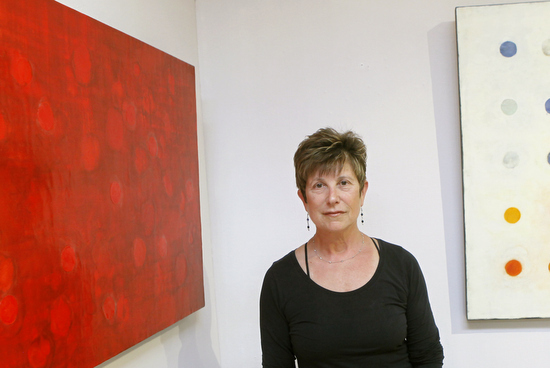
Tell me about your childhood and formative experiences: how old were you when you first showed an interest in art?
I'm very fortunate that my parents loved art and collected Japanese prints. My mother had a small ceramics studio in our house where I could play and I always had crayons and paper: she made sure I was enrolled in art and music classes and that I attended art camp during the summer. On Saturday mornings, we'd go to matinees, exhibitions and concerts geared specifically to children at UCLA.
I was 3 when I started drawing and playing the piano. Always supportive of my interest in art, my mother entered a tempera painting I made when I was 5, Hot Dogs and Arrows, in a local art competition; it won third prize!

As a graduate student you focused on music and also did some conducting in Boston. Tell me about this era and how it shaped you.
As an undergraduate, I studied music theory and composition, which was interesting, but not terribly exciting. My group of peers at UCLA would get together and perform early music weekly. Each of us had the opportunity to conduct and that is what really excited me: bringing music to life through interpretation and performance.
In Boston as a graduate student in conducting, I worked at Northeastern University as assistant conductor for two years and at Harvard-Radcliffe University as conductor of the Graduate Chorale for one. Conducting requires physical movement and communication, like dancing, which was fun and incredibly fulfilling. I got to hang out with John Cage and Philip Glass, and both of those contacts inform my work to this day.
I moved to L.A. after graduate school and created my own performing group with two friends who are currently very involved in the classical music scene. While I no longer perform, music is part of who I am. It's present in the way I develop line and composition in my work; for each element in music, there is its corollary in art.
I was invited to be the 2014 Visual Artist for the Music at Menlo Chamber Music Festival and Institute this summer. When I asked the directors why they chose my work they mentioned my use of color and rhythm which reflects the transition from 19th to 20th century Central European composers that are being featured this year.
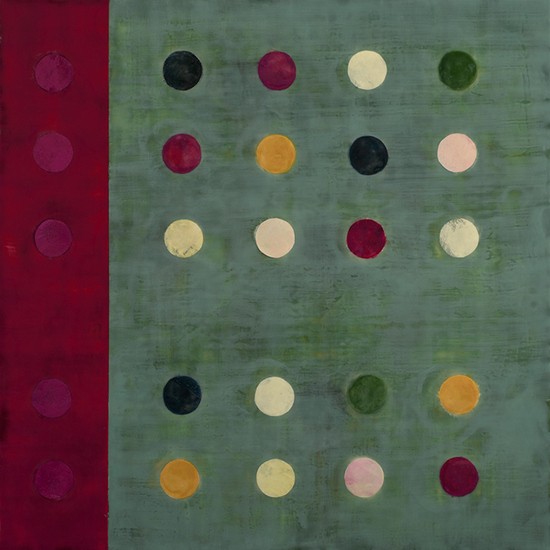
While still pursuing music you also took courses in painting and drawing. How and when did you come to the realization that you needed to make art your primary pursuit?
In 1991, after working for 11 years as a freelance musician, I longed for the solitude a studio practice could provide. There were always interpersonal issues working with musicians and staff. Additionally, I was limited in what I could achieve in the conducting field as a woman, even though I had a degree from a renowned music conservatory. I grew frustrated and impatient when preforming became less about the music and more about other things. So, I picked up my drawing pencils and would sit for many hours drawing peacefully and happily. The rest is history.
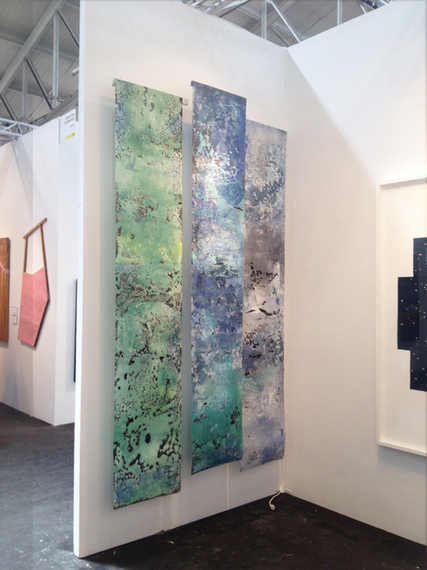
You have said that you work at the "intersection of art, math and music". Tell me about some of the ways that these three fields overlap.
Music theory is an analysis of relationships: intervals between tones -- melodically and harmonically -- rhythm and meter, scales and keys. The frequency of sound waves that produce pitch can be measured mathematically. This is a very simple response to a complex answer.
I often use mathematical formulae in my art. For example, in my current series, (r)evolution, I pre-determine the colors to be used, how many times they appear and how they appear in the composition. It is important how and where a viewer enters my painting and how his/her eye travels around the composition. (r)evolution is about pattern within a grid structure. Other series include a grid structure, but more organic gestures within that framework. I like to say that my work exists on the "continuum between gesture and geometry": I used that phrase as the title of my 2011 exhibition at the Fresno Art Museum.
Tell me about your interest in printmaking and describe some of your work in that medium.
After seeing the Met's exhibition, the Painterly Print in the 80's I knew I had to learn how to make monotypes. I signed up for a class at the Provincetown Fine Arts Center and studied with one of the best, Michael Mazur. I received so much from him including his enormous generosity as a teacher.
Monotypes are transfer paintings from plate to paper, created in the moment, and can be used as studies for future paintings or they can exist on their own as prints. I have made hundreds of monotypes and monoprints (using a matrix). In 2007, I learned a new, but similar process of making an encaustic (pigmented wax) monotype on a hot aluminum table. The most exciting works I've done have been my encaustic prints on Japanese scrolls. Some of them are 24' long and have been exhibited as groupings and walk-through installations in museum exhibitions.
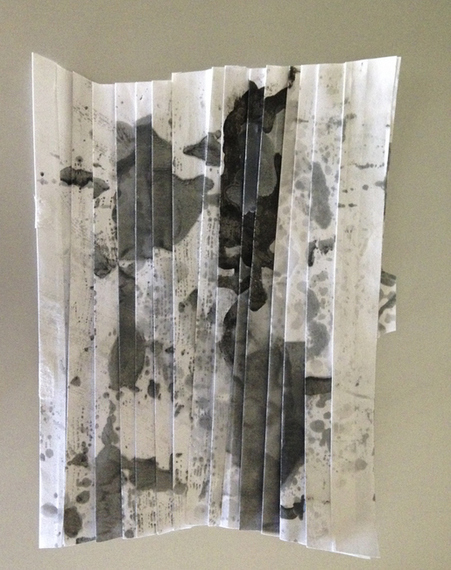
One of your recent projects started with a simple exercise in folding paper, but has grown much larger. Tell me a bit about the development of this work.
I love working with paper. My new series, Folded, deals with a way of representing time spent in the studio day-to-day through the use of folds. Each day has a certain number of folds I make that correspond to the day in the month. For example, the piece made on June 14 has 14 folds. The folds are different widths, corresponding to a calculation I made for each piece. The papers used are fragments of encaustic monotypes created on different Japanese papers; the monotypes were made close to the same time as the folded piece was made.
This project developed as my other collage projects have - out of a need to break away from whatever painting or show I'm working on in order to work in a less intense but more playful way. Initially, I set certain parameters for myself: the maximum time spent on each folded piece would be less than an hour and no piece would be larger than 12"x12". Many of the pieces are smaller.
Recently, I've begun to make my work larger as this has been such a fun break from painting. Collage has always been my default and comfort for those frustrating and trying moments in the studio and in life. It is the perfect balance of intention and chance.

After hearing about the work of chemist Roger Linington on NPR - a chemist who is investigating the healing properties of marine bacteria - you visited him and became excited about the potential of his work. Where do you think this connection is going to lead?
My next step is to return to Roger's lab to get a look at specimen slides under the microscope. Once I have actual visuals, I'd like to begin work on a large installation that will include my scrolls and three-dimensional forms fabricated from my scroll paintings. The imagery would be the healing bacterium, each with its own unique shape, internal structure and color. I can visualize someday walking through this installation that might look like a giant petri dish -- bacterium suspended from the ceiling to the floor in the form of sculptures and scrolls. Once completed, I'd like to write a proposal and submit it to appropriate non-profit, science and art museums for possible exhibition.
Tell me about your sense of humor and how it infuses your work?
This one is tough, John. My sense of humor is communicated through conversations with friends and students more than through my art.
That said, in my current series, (r)evolution, I'm playful in my choice of color and rhythm e.g. placement and color of the circles. The Folded series is also playful. I'm also a pretty good mimic and can be very silly at times, dissolving into giggles easily. I'm able to laugh at myself, at mistakes I make, especially when teaching. I have the ability to see the lighter side of life's often illogical situations by not getting bogged down in the negative or trite: it's something I've focused on most of my adult years.
My perspective changed dramatically when, at 16, I read Ram Dass', Be Here Now. It was a life-altering book for me. Currently, I'm reading Kay Larson's, Where the Heart Beats: John Cage, Zen Buddhism and the Inner Life of Artists. It's a wise book that helps me maintain a live-in-the-present-moment perspective.
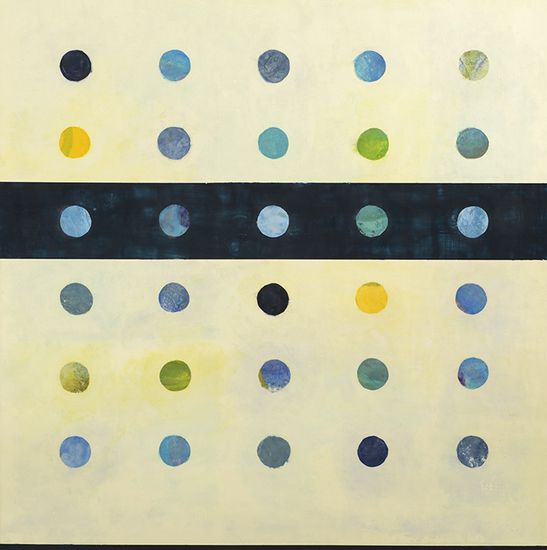
Is there anything else about your current work or artistic practice that you would like to mention?
Everything in my life is interconnected: my painting and current projects in the works, my yoga practice, my teaching, and my relationships.
At this point in your life and career what matters most to you?
Several things: what's most important to me is having the freedom to create the kind of art that is most fulfilling and not necessarily what a gallery/dealer wants. That is why I'm excited about my two latest projects. Also, it's important to pay it forward and give back where I'm able. At the other end of the spectrum, I take great joy and pleasure teaching yoga and Pilates. I have many responsibilities, but this one is special as it's not about me, but helping others with certain physical and emotional conditions regain their independence and live a more quality-filled life.
Tracey Adams: Current Exhibitions
Tracey Adams: Patterns of Infinity
Bryant Street Gallery - Palo Alto, CA
July 15 - August 31
Outside/In
K. Imperial Fine Art - San Francisco, CA
July 15-August 31
SHIFT: Five Decades of Contemporary California Painting
Monterey Museum of Art - Monterey, CA
May 1-September 22